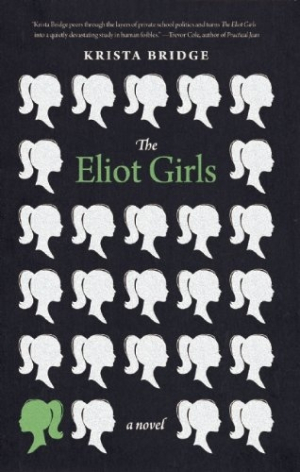The Eliot Girls
The often hidden aspects of the life of a female adolescent are portrayed honestly and sometimes gut-wrenchingly.
Mother and daughter Ruth and Audrey find themselves floating away from one another amidst a sea of pedigreed young women in The Eliot Girls, by Krista Bridge. Ruth, a teacher at prestigious George Eliot Academy, is thrilled that her daughter, Audrey, has at long last been accepted to the school after numerous failed admissions tests. Audrey, for all her striving, quickly finds herself lost and lonely, particularly as she navigates the realization that George Eliot is not at all what she longed for it to be.
Bridge’s writing is effortless, with keen descriptions that peel away the layers of veneer her characters put up—consciously and unconsciously—for others. Beautiful, intelligent Ruth comes face to face with her own midlife ennui when a new teacher at the school, Henry Winter, initiates a romantic connection with her. It is with a great deal of craft that Bridge delves into the complex—yet somehow simple—emotions that lead to infidelity: the deep sense of misdeed that intertwines with a near complete lack of concern for the consequences.
The novel also succeeds in its rendering of female adolescence, in all its heartrending, gut-wrenching gore and glory. Fans of Mean Girls and Gossip Girl will not be able to help but see the connections between Regina George, Blair Waldorf, and Eliot’s Arabella Quincy, though there are several moments that belie the queen bee’s hard-line authority, lending her a conscience—if only an inkling of one.
Perhaps most affectingly, The Eliot Girls portrays women inhabiting roles society largely deems unacceptable or unsavory. Bridge expertly takes us there—to Ruth’s guiltless desire for her lover, to Audrey’s willingness to be used by the school’s most powerful students. Moments that explore these often hidden aspects of a woman’s life and psyche are rendered without judgment. Rather, Bridge offers them artfully and with an appropriate amount of melancholy. One is left a little bare, a little lost—but also somewhat hopeful for what comes after the veneer is peeled away.
Reviewed by
Margaret Fedder
Disclosure: This article is not an endorsement, but a review. The publisher of this book provided free copies of the book to have their book reviewed by a professional reviewer. No fee was paid by the publisher for this review. Foreword Reviews only recommends books that we love. Foreword Magazine, Inc. is disclosing this in accordance with the Federal Trade Commission’s 16 CFR, Part 255.

